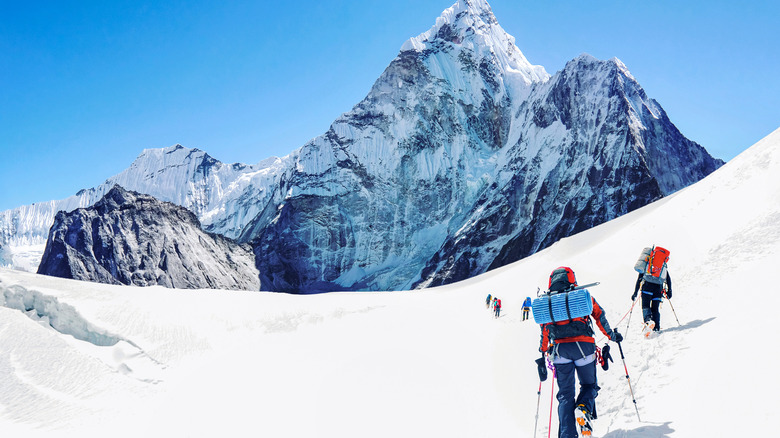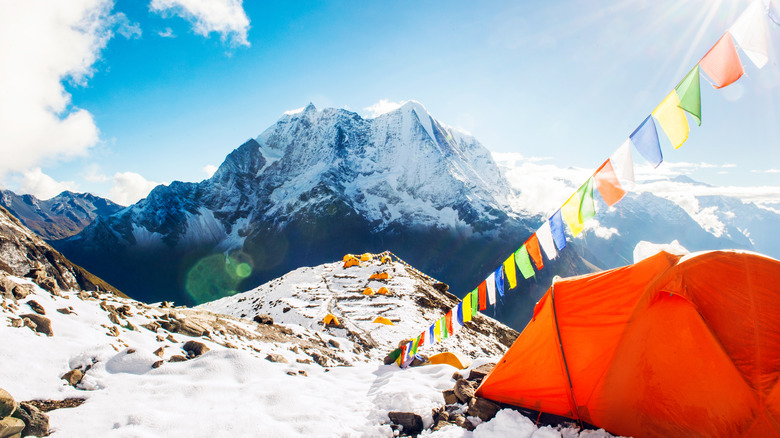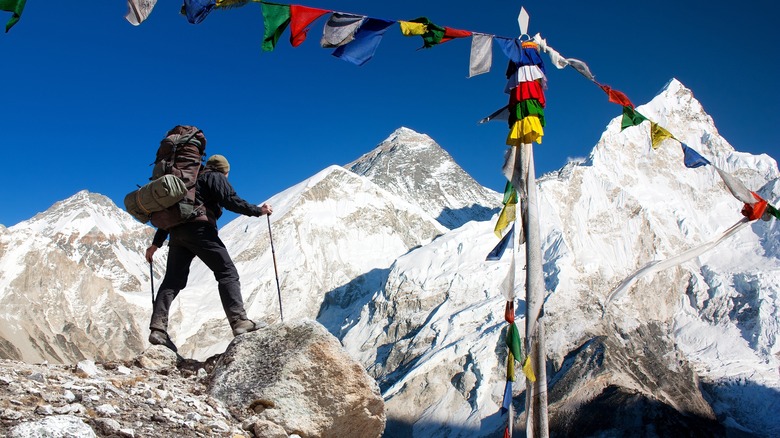Here's How Many Dead Bodies Have Been Recovered From Mount Everest
Located on the border of Nepal and Tibet, Mount Everest is considered to be the world's highest mountain (via Global Adventures Challenge). This title, however, has failed to sway explorers from all corners of the world from attempting to climb it. According to History, Edmund Hillary and Tenzing Norgay were the first to reach Everest's summit in 1953. This came after several failed attempts by other climbers, including a 1924 expedition that resulted in the disappearance of explorers George Mallory and Andrew Irvine. Since then, Alan Arnette writes that Everest has been summited over 10,000 times. Moreover, approximately 800 people each year try their hand in climbing it (per The Explorers Passage).
This, of course, is no easy feat. There is only a small window of time for Everest to be climbed, with May considered the "ideal" month. Per China Highlights, the journey can take up to two months (most of which is spent acclimating to the conditions). In addition, an Everest expedition can cost anywhere between $40,000 and $160,000 (per Alan Arnette). The financial damage, however, is the least of it.
One can expect hypothermia, frostbite, and a plethora of other physical and psychological ailments. That is, if the climber doesn't die first. ABC News reports that most people die on Everest due to "falls, storms, avalanches, lack of oxygen, freezing, or underlying health issues." As a result, 305 people have died between 1924 and 2021. As Ranker puts it, dying while climbing Everest is nothing short of "horrifying."
Mount Everest's death zone
According to Business Insider, the highest part of Everest is called "The Death Zone." At 26,247 feet, the body begins to die due to the lack of oxygen. As the climber's brain and lungs are being "starved" from oxygen, the risk of stroke, heart attack, and "impaired" judgment increases. One climber described it as "running on a treadmill and breathing through a straw." Per the National Center for Biotechnology Information, there's also altitude sickness. While it can cause headaches and nausea, it can lead to "psychosis" and ultimately death. Some hallucinate, including one climber who thought he was on a sailboat.
In addition, there is also the risk of blindness, gangrene, and a lack of appetite and sleep. It's for this reason that All That's Interesting stated that climbers are only expected to live for only 48 hours in the death zone. PBS reports that a climber appropriately described the death zone as a "living hell." A 2008 study found that 59% of deaths on Everest were due to trauma, while 14% were unknown as the bodies were never found (per Outside Magazine). The rest were non-traumatic and due to altitude sickness and other factors.
What happens to a climber's body while they die on Everest? Ranker writes that extreme exhaustion will set in and the arms and legs will freeze. Ultimately, the person will fall asleep or lose consciousness and die. Their body will most likely forever remain on Mount Everest as a marker and perhaps as a warning.
Retrieving bodies from Mount Everest
Per The Sky Above Us, recovering bodies from Mount Everest is "near impossible," but it is done. It's for this reason that it's often referred to as "the world's highest graveyard." Ranker writes that wherever a climber falls is where they will stay, as it's "too risky" to make the climb. Those who die on the mountain are remarkably well-preserved, as they are frozen all year long. However, this also makes them incredibly burdensome to retrieve and not "worth" the trouble.
According to The Washington Post, Sherpas, the native people from the Himalayas (via China Highlights), are the ones who are risking their lives to bring dead bodies back from Everest. Usually, a group of up to 10 Sherpas head to the death zone, where most of the bodies are. They then use a sled to transport the body to an area low enough where a helicopter can pick them up, all while risking a possible avalanche.
It's for this reason that the South China Morning Post wrote that as of August 2020, it's estimated that 150 people who died on Everest have been retrieved. The rest of the bodies remain on the mountain, as it can cost up to $100,000 to bring them back down. Sherpas have noted that cleaning trash off the mountains is more important, as it has been piling up since 1953. Others believe the bodies should be left there "out of respect for the dead climbers."


